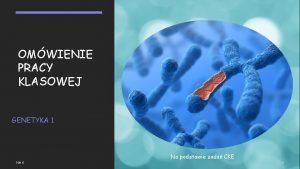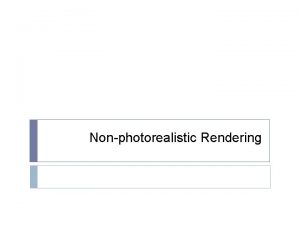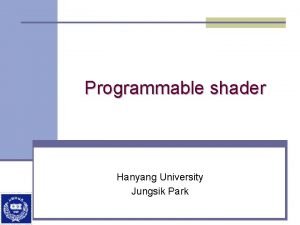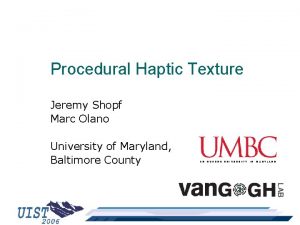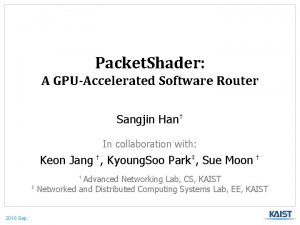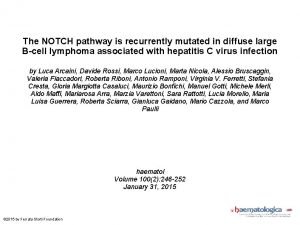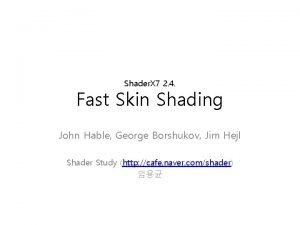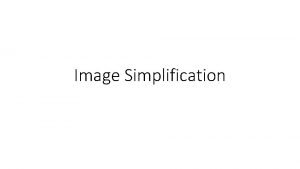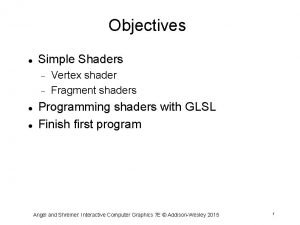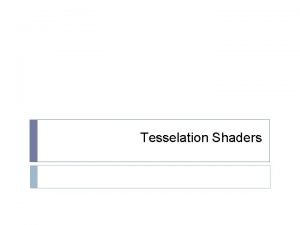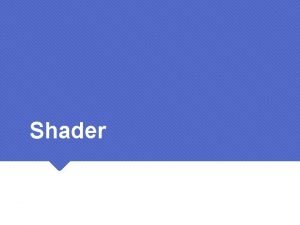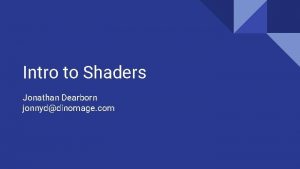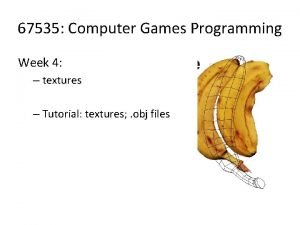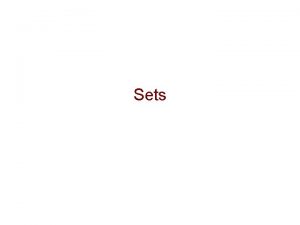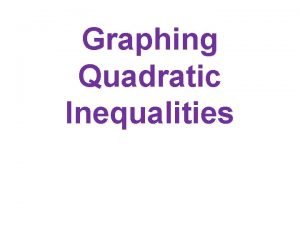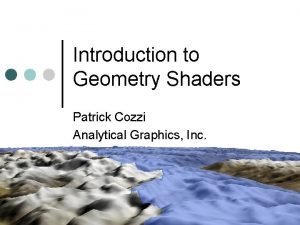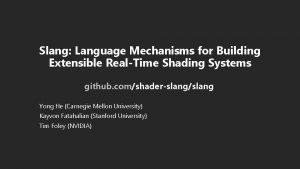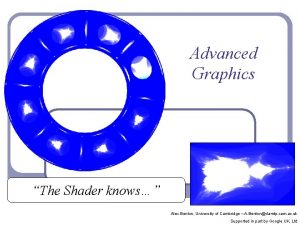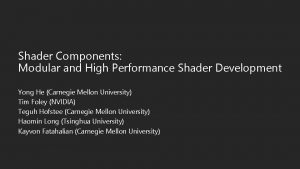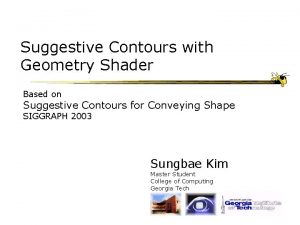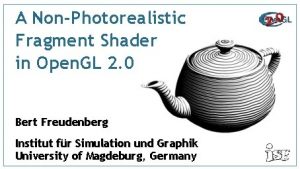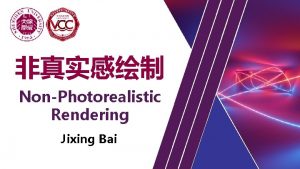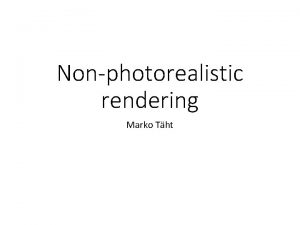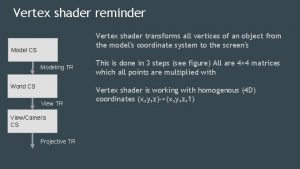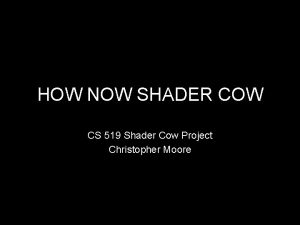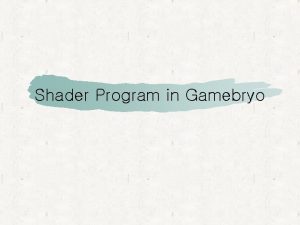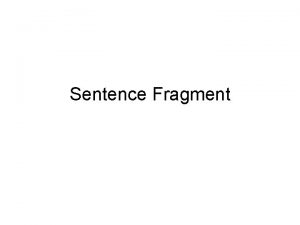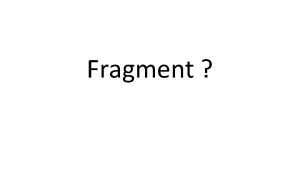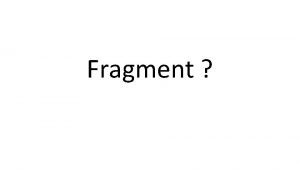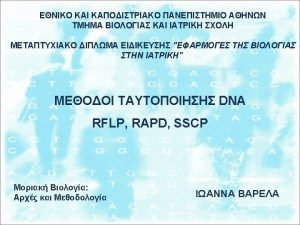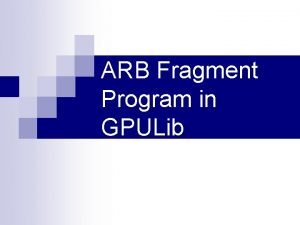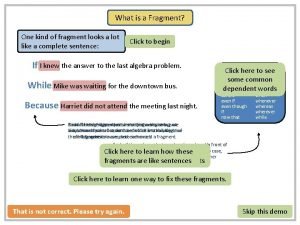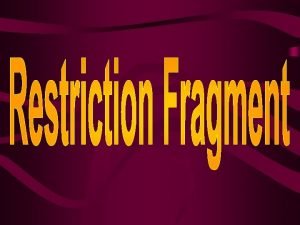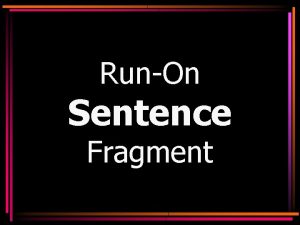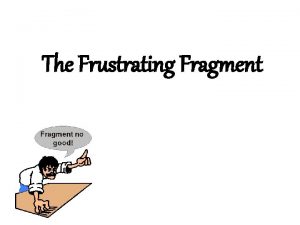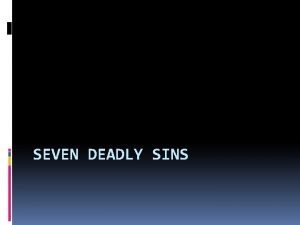A NonPhotorealistic Fragment Shader in Open GL 2


























- Slides: 26

A Non-Photorealistic Fragment Shader in Open. GL 2. 0 Bert Freudenberg Institut für Simulation und Graphik University of Magdeburg, Germany

Outline • Open. GL 2. 0 proposal • Vertex and fragment shaders • Non-photorealistic shading • Anti-aliasing in a shader • Lighting • Adding noise • Conclusion Bert Freudenberg, University of Magdeburg

Open. GL 2. 0 Proposal Shading Language • High-level language for • vertex shaders • fragment shaders • even more • Experimentally implemented as GL 2 extension • available on 3 Dlabs Wildcat VP Bert Freudenberg, University of Magdeburg

Base for our shader Scott F. Johnston’s “Mock Media” • From “Advanced Render. Man: Beyond the Companion” (SIGGRAPH ’ 98 Course #11) • Render. Man surface shader for woodprint-like appearance • Shading by lines of varying width Bert Freudenberg, University of Magdeburg

Vertex Shader • Uses constant and per-vertex data to set up attributes varying across the primitive • Our shader: • one surface parameter • screen-space position Bert Freudenberg, University of Magdeburg

Vertex Shader varying float v; void main(void) { v = gl_Multi. Tex. Coord 0. s; gl_Position = gl_Model. View. Projection. Matrix * gl_Vertex; } Bert Freudenberg, University of Magdeburg

Fragment Shader • Gets interpolated varying parameters • Similar to Render. Man surface shader • Evaluates some function to output color at a certain point in parameter space • Our shader: • output black or white to create lines Bert Freudenberg, University of Magdeburg

Parameter varying float v; v = texcoord 0. s; • Assigned in vertex shader • Interpolated value in fragment shader Bert Freudenberg, University of Magdeburg

Sawtooth wave sawtooth = fract( v * 16. ); Bert Freudenberg, University of Magdeburg

Triangle wave triangle = abs(2. * sawtooth - 1. ); Bert Freudenberg, University of Magdeburg

Square wave square = step(0. 5, triangle); • Aliasing! Bert Freudenberg, University of Magdeburg

Anti-aliasing • FSAA will not help • just raises resolution • Need to remove higher frequencies • manually • Step function has unlimited frequency • use smooth step instead Bert Freudenberg, University of Magdeburg

Constant width smoothstep() square = smoothstep(0. 4, 0. 6, triangle); • Buggy, hence: edge 0 = 0. 4; edge 1 = 0. 6; t = clamp((triangle - edge 0) / (edge 1 - edge 0), 0. , 1. ); square = t * (3. - 2. * t); • Aliasing + blurring Bert Freudenberg, University of Magdeburg

Derivatives • d. Pdx(v), d. Pdy(v) • Derivative of parameter v in screen x and y Bert Freudenberg, University of Magdeburg

Length of derivative dp = length(vec 2(d. Pdx, d. Pdy)); Bert Freudenberg, University of Magdeburg

Adaptive filter width filterstep() float edge = 0. 5; float w = 64. * dp; float square = clamp((triangle + 0. 5 * w - edge) / w, 0. , 1. ); Bert Freudenberg, University of Magdeburg

Raising frequency • No more individual lines • Too dense in certain regions • Adjust frequency based on screen space density Bert Freudenberg, University of Magdeburg

Partitioning by derivative ilogdp = floor(log 2(dp)); • No log 2() yet • Texture as lookup table vec 3 tex 0 = texture 3(0, dp * 8. ); float logdp = (tex 0. r - 0. 5) * 256. + tex 0. g; Bert Freudenberg, University of Magdeburg

Adjusting frequency exp 2(floor(log 2(dp))) * f; • frequency doubles in discrete steps • also works for distance! Bert Freudenberg, University of Magdeburg

Tapering ends • linearly interpolate to double frequency t = fract(log 2(dp)); triangle = abs((1. + t) * triangle - t); Bert Freudenberg, University of Magdeburg

Lighting Vertex Shader pos = vec 3(gl_Model. View. Matrix * gl_Vertex); tnorm = normalize(gl_Normal. Matrix * gl_Normal); vec 3 light. Vec = normalize(Light. Position - pos); light. Intensity = max(dot(light. Vec, tnorm), 0. 0); Bert Freudenberg, University of Magdeburg

Lighting • Line width dependent on lighting • Adjust threshold by light intensity square = step(light. Intensity, triangle); Bert Freudenberg, University of Magdeburg

Noise • No noise() yet 3 D tilable noise tex = ( F(x, y, z)*(t-x)*(t-y)*(t-z)+ F(x-t, y, z)*(x)*(t-y)*(t-z)+ F(x-t, y-t, z)*(x)*(y)*(t-z)+ F(x, y-t, z)*(t-x)*(y)*(t-z)+ F(x, y, z-t)*(t-x)*(t-y)*(z)+ F(x-t, y, z-t)*(x)*(t-y)*(z)+ F(x-t, y-t, z-t)*(x)*(y)*(z)+ F(x, y-t, z-t)*(t-x)*(y)*(z)) /(t*t*t); Bert Freudenberg, University of Magdeburg

Noisy width • Bias threshold Bert Freudenberg, University of Magdeburg

Noisy wiggles Bert Freudenberg, University of Magdeburg

Conclusion • Learn about Render. Man shaders • Translate to Open. GL 2. 0 • almost straight-forward • Anti-aliasing is an issue • use derivatives • Non-photorealistic Rendering is cool! Bert Freudenberg, University of Magdeburg
 Podaj oznaczenie literowe nukleozydu
Podaj oznaczenie literowe nukleozydu Open 4es shaders
Open 4es shaders Open innovation open science open to the world
Open innovation open science open to the world Gooch shading model
Gooch shading model 셰이더 로드 및 컴파일
셰이더 로드 및 컴파일 Vray toon shader maya
Vray toon shader maya Dynamic penetration shader
Dynamic penetration shader Packets
Packets Hpse shader
Hpse shader Hull shader
Hull shader Shader model 5
Shader model 5 Citra post processing shader
Citra post processing shader George borshukov
George borshukov Kuwahara filter unity
Kuwahara filter unity Simple vertex shader
Simple vertex shader What is tesselation
What is tesselation Glsl outline
Glsl outline Sdl_gpu
Sdl_gpu Skybox shader
Skybox shader Power set
Power set Quadratic inequality shading
Quadratic inequality shading Gl_triangles_adjacency
Gl_triangles_adjacency Nvidia slang
Nvidia slang Gooch shader
Gooch shader High performance shader
High performance shader Suggesstive
Suggesstive Cg shading language
Cg shading language
